Lost Dutchman State Park
- January 22, 2024
- 0 comment
Located in the Superstition Mountains of Arizona, Lost Dutchman State Park is a landscape rich in natural beauty and local legend. Renowned for its scenic hiking trails and the enigmatic tale of the Lost Dutchman’s gold mine, this park offers a unique combination of outdoor adventure and historical intrigue.
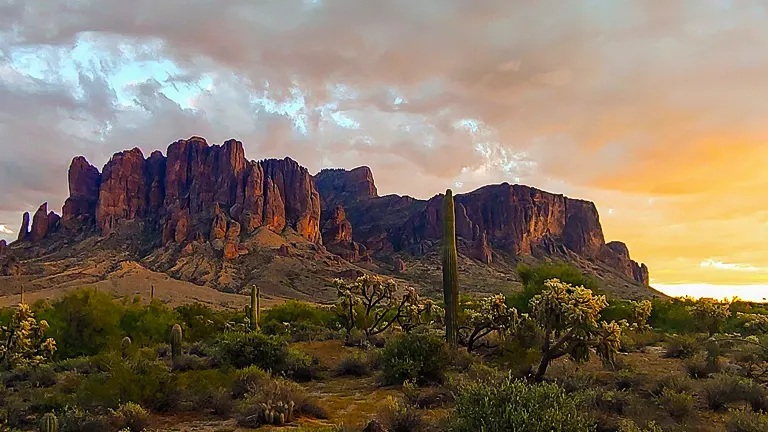
With its array of trails catering to all levels of hikers and its stunning desert vistas, Lost Dutchman State Park is an ideal destination for nature enthusiasts and those seeking a glimpse into Arizona’s storied past.
Characterizing Features of Lost Dutchman State Park
- Size and Location Lost Dutchman State Park, encompassing 320 acres, is located in the northwestern Pinal County, Arizona. It is situated along the Apache Trail (State Route 88), north of Apache Junction, near the Superstition Mountains. This proximity to central Arizona and being about 40 miles east of Phoenix via U.S. Highway 60 makes it readily accessible and a favored destination for both locals and tourists.
- Historical Significance The park is steeped in the lore of the American Old West, named after the fabled Lost Dutchman’s Gold Mine. This mine, legendary in Western tales, is said to be rich in gold, and the mystery surrounding its location and the fate of its finder, Jacob Waltz, adds a layer of intrigue and historical curiosity to the park.
- Geological Features The Superstition Mountains, a highlight of the park, dominate the landscape. These mountains are not only a key feature for their scenic beauty but also for their geological significance. The rugged terrain, composed of volcanic rock and remnants of an ancient volcanic eruption, provides a dramatic backdrop and a unique geological setting for visitors.
- Recreational Gateway Lost Dutchman State Park serves as an important access point for the Superstition Wilderness Area. With its hiking trails and mountain bike paths, the park acts as a gateway for adventurers seeking to explore the more remote and rugged terrains of the Superstition Wilderness, which offers a true immersion into the natural beauty of Arizona’s desert landscape.
- Wildlife and Flora The park is home to a diverse range of desert flora and fauna. It’s a place where visitors can spot a variety of wildlife, including desert mule deer, coyotes, and a myriad of bird species. Additionally, the park’s flora is representative of the Sonoran Desert, featuring saguaro cacti, cholla, and ocotillo plants, among others. This rich biodiversity adds to the park’s appeal as a destination for nature enthusiasts and wildlife photographers.
- Recreational Facilities Beyond its natural and historical attributes, Lost Dutchman State Park is equipped with various recreational facilities. These include a campground with amenities, picnic areas, and a visitor center that offers insights into the park’s natural and cultural history. These facilities make the park not just a place of scenic and historical interest, but also a convenient and comfortable destination for day trips and extended stays.
- Trails and Hiking Opportunities Among its most significant features are the hiking trails, such as the popular Siphon Draw Trail and the challenging Superstition Ridgeline Trail. These trails offer a range of experiences, from easy walks to strenuous hikes, catering to all levels of hiking enthusiasts. The trails not only provide physical challenges but also offer stunning views of the surrounding landscape, making them a highlight for visitors.
Each of these features contributes to the unique character of Lost Dutchman State Park, making it a cherished destination for its natural beauty, rich history, and recreational opportunities.
History of Lost Dutchman State Park
Lost Dutchman State Park, with its captivating blend of natural beauty and legend, has a history deeply intertwined with the American Old West. The park, named after the infamous Lost Dutchman’s Gold Mine, is steeped in tales of hidden treasure and the enduring mystery of its location. According to legend, in the 1870s, a German immigrant named Jacob Waltz discovered a rich gold mine within the Superstition Mountains but took its secret location to his grave. This story has fascinated treasure hunters and adventurers for over a century, with many still combing the wilderness in hopes of finding the lost mine. The allure of this legend has been a significant factor in the park’s popularity and cultural significance.
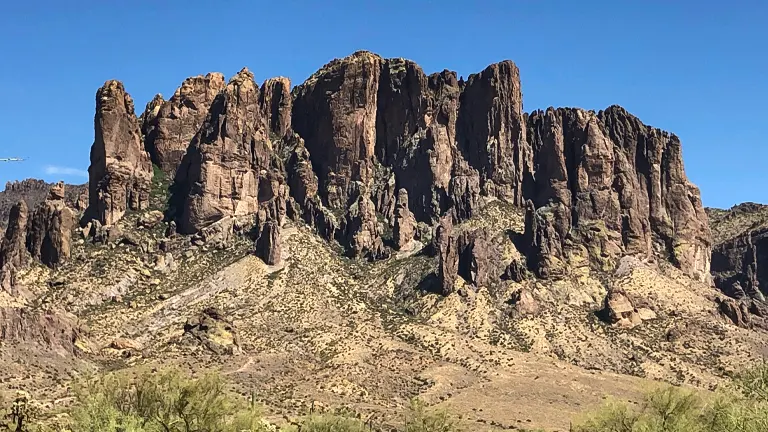
The physical development of Lost Dutchman State Park began in 1972 when the area was first established as a day-use recreation site by the federal Bureau of Land Management. This initial development included the construction of essential amenities such as paved roads, picnic facilities, restrooms, and a parking lot, along with a sewage treatment plant and an electrical system, to support the growing number of visitors. In 1977, after a legislative action, the state of Arizona acquired 292 acres of this land, establishing Lost Dutchman State Park. The park later expanded by an additional 28 acres leased in 1983. Over the years, the park has grown into a well-equipped recreational area, balancing the preservation of its natural and historical heritage with providing a range of recreational opportunities for visitors.
Importance in Conservation and Recreation in Lost Dutchman State Park
Lost Dutchman State Park plays a crucial role in the conservation of Arizona’s unique desert ecosystem, while simultaneously offering a myriad of recreational opportunities. As a conservation area, the park is pivotal in preserving the distinctive flora and fauna of the Sonoran Desert. It acts as a sanctuary for various species, including native plants like the saguaro and cholla cacti, and wildlife such as the Gila monster, javelina, and desert mule deer. These conservation efforts are vital for maintaining the region’s biodiversity and ecological balance, making the park an important center for environmental education and awareness.

In terms of recreation, Lost Dutchman State Park is a premier destination for outdoor enthusiasts. Its extensive network of trails provides ample opportunities for hiking, mountain biking, and exploring the rugged beauty of the Superstition Wilderness. These trails range from easy walks to challenging hikes, catering to all skill levels and making the park a haven for both casual visitors and seasoned adventurers. Furthermore, the park’s facilities, including its campgrounds and picnic areas, enhance the recreational experience, offering visitors a chance to immerse themselves in the natural world. This combination of conservation and recreation not only makes Lost Dutchman State Park an invaluable resource for the community but also a significant contributor to the region’s natural and cultural heritage.
Unique Location of Lost Dutchman State Park
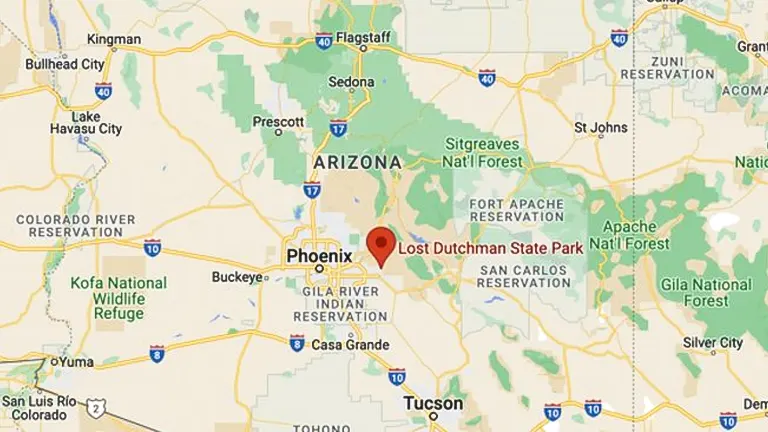
Lost Dutchman State Park boasts a unique location that sets it apart as a natural jewel within the Arizona landscape. Situated in northwestern Pinal County, the park is strategically placed on the Apache Trail, north of Apache Junction, near the enigmatic Superstition Mountains in central Arizona. This positioning near the urban expanse of Phoenix, about 40 miles east via U.S. Highway 60, makes it a convenient escape to the wilderness for city dwellers and visitors alike. The park’s proximity to the Superstition Mountains is particularly significant; these mountains are not only a stunning backdrop with their dramatic cliffs and peaks but also a source of rich folklore and geological interest. The blend of the park’s rugged desert terrain, the mystique of the legendary Lost Dutchman’s Gold Mine, and its accessibility from a major urban center create a unique destination. It offers an ideal mix of adventure, history, and natural beauty, making it a compelling spot for both recreation and relaxation, attracting a diverse range of visitors from hikers and history enthusiasts to photographers and nature lovers.
Diverse Vegetation and Plant Species in Lost Dutchman State Park
- Saguaro Cactus (Carnegiea gigantea) The saguaro cactus, Arizona’s state flower, is a defining feature of Lost Dutchman State Park. These towering cacti, which can live for over 150 years, are iconic symbols of the American Southwest. Their majestic silhouettes against the backdrop of the Superstition Mountains create a quintessential desert landscape that is both awe-inspiring and representative of the park’s ecological diversity.
- Cholla Cactus (Cylindropuntia) The park is also home to various cholla cacti, known for their distinctive segmented branches and spiny cover. These plants are vital to the desert ecosystem, providing habitat and food for various wildlife species. Their blooming flowers in the spring add a splash of color to the arid landscape.
- Ocotillo (Fouquieria splendens) Ocotillo plants are easily recognizable by their long, spindly branches that reach skyward. After rain, these plants quickly sprout small leaves, and their tips bloom with bright red flowers, offering a stark contrast to the desert’s typically muted tones. Ocotillos are not true cacti but are unique desert plants that add to the park’s botanical diversity.
- Creosote Bush (Larrea tridentata) This evergreen shrub is known for its resilience in arid environments. The creosote bush has small, waxy leaves and produces yellow flowers. It’s famous for its distinctive smell after rain, often described as the quintessential scent of the desert.
- Palo Verde (Parkinsonia spp.) The Palo Verde, Arizona’s state tree, thrives in the park. Its name, meaning “green stick,” comes from its green bark, which the tree uses for photosynthesis. The Palo Verde blooms with beautiful yellow flowers in the spring, adding a vibrant touch to the landscape.
- Brittlebush (Encelia farinosa) The brittlebush is another common sight, characterized by its silver-gray leaves and yellow daisy-like flowers. It’s a hardy plant that survives in harsh desert conditions and blooms profusely in the spring, attracting a variety of pollinators.
- Mesquite Trees (Prosopis) Mesquites, with their deep root systems, are vital to stabilizing the sandy desert soil. These trees provide valuable shade and produce bean pods that are a food source for wildlife and have been used historically by indigenous peoples for food and tool-making.
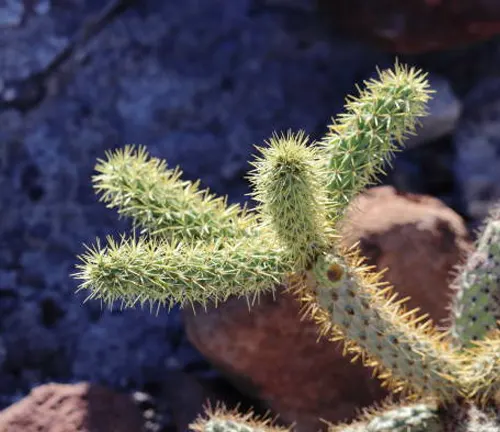
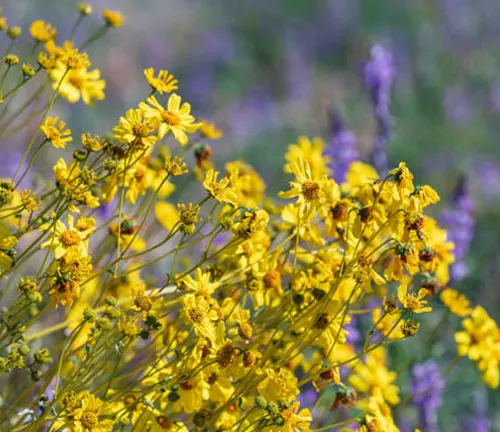
Fauna in Lost Dutchman State Park
- Desert Mule Deer (Odocoileus hemionus) The Desert Mule Deer, known for its large ears resembling those of a mule, is a common sight in Lost Dutchman State Park. These deer are well-adapted to the arid environment and can often be seen grazing in the cooler hours of dawn and dusk, adding a gentle presence to the rugged landscape.
- Coyote (Canis latrans) The coyote, a symbol of the American Southwest, is an adaptable and intelligent animal frequently spotted in the park. Known for their resourcefulness, coyotes play a significant role in the park’s ecosystem as both predators and scavengers.
- Javelina (Pecari tajacu) Often mistaken for wild pigs, javelinas are actually peccaries – a distinct species native to the American Southwest. These social animals typically travel in herds and are an exciting sighting for visitors, though it’s important to maintain a safe distance as they can be protective of their group.
- Gila Monster (Heloderma suspectum) The Gila Monster, one of the few venomous lizards in North America, is a rare but remarkable creature to spot. They are known for their distinctive black and orange-pink patterns and can often be found in rocky areas or near washes.
- Roadrunner (Geococcyx californianus) The Greater Roadrunner, a fast-running bird famous from popular culture, is a fascinating sight in the park. These birds are easily recognized by their long tails and crest of feathers, and they are known for their ability to catch a variety of prey, including insects and small reptiles.
- Desert Cottontail (Sylvilagus audubonii) The Desert Cottontail, a common rabbit species in the Southwestern United States, can often be seen darting among the underbrush. Their presence adds charm to the park’s terrain and they play an important role as a prey species in the desert food chain.
- Bobcat (Lynx rufus) While more elusive, bobcats are a magnificent predator in the park. These medium-sized cats, with their distinctive tufted ears and spotted coat, are a testament to the diverse wildlife that calls the park home.
- Western Diamondback Rattlesnake (Crotalus atrox) The Western Diamondback Rattlesnake, a common venomous snake in the American Southwest, is often found in the park. They play a critical role in controlling rodent populations, and their presence, while commanding respect and caution, underscores the wild essence of Lost Dutchman State Park.
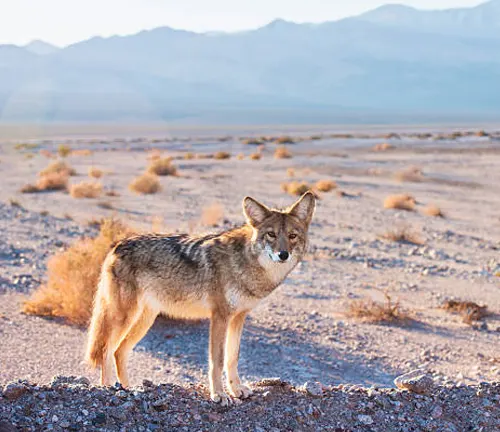
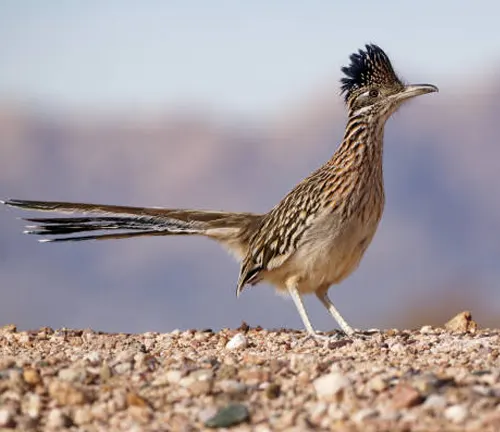
Attractions in Lost Dutchman State Park
The Legend of the Lost Dutchman’s Gold Mine: The park is named after the legendary Lost Dutchman’s Gold Mine, enveloped in tales of hidden riches discovered by German immigrant Jacob Waltz in the 19th century. The mystery surrounding the mine’s location continues to intrigue visitors, making it a focal point of the park’s allure and a topic of interest for treasure hunters and history enthusiasts.


Superstition Mountain Museum: Situated near the park, the Superstition Mountain Museum offers an insightful look into the area’s history, particularly focusing on the Lost Dutchman’s Gold Mine legend. The museum features a range of exhibits, including artifacts, photographs, and historical accounts that paint a vivid picture of the region’s mining past and the cultural significance of the Superstition Mountains.
Goldfield Ghost Town A short distance from the park, Goldfield Ghost Town recreates the ambiance of a 1890s mining town. Visitors can explore this reconstructed town to experience a slice of Arizona’s gold mining history, complete with historic buildings, mining tours, and Old West-style gunfight reenactments, adding a unique and educational dimension to the park experience.


Photography and Wildlife Viewing The diverse terrain and wildlife of Lost Dutchman State Park make it an exceptional location for photography enthusiasts and nature watchers. The contrasting landscapes, from majestic saguaros to vibrant sunsets, alongside a variety of desert wildlife, provide ample opportunities for capturing stunning photographs and observing Arizona’s natural beauty.
Apache Trail The park is a renowned stop along the Apache Trail, one of Arizona’s most scenic drives. This historic route winds through spectacular desert landscapes, offering panoramic views of canyons, deserts, and lakes, appealing to those who enjoy scenic drives and the exploration of Arizona’s diverse wilderness.
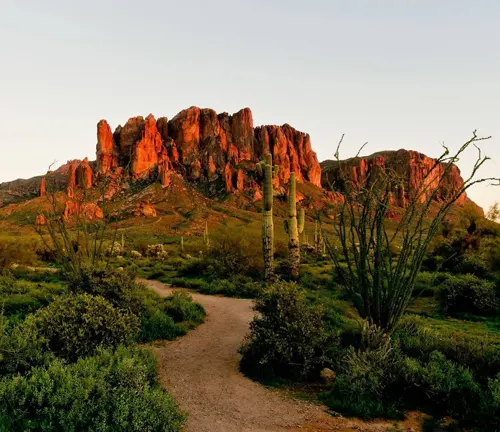
These attractions, each with its unique charm, make Lost Dutchman State Park a destination that offers more than just outdoor activities. From delving into intriguing local legends to enjoying serene natural settings, the park caters to a wide spectrum of interests and provides a rich, multifaceted experience to its visitors.
Recreational Activities in Lost Dutchman State Park
- Hiking Lost Dutchman State Park is a hiker’s paradise, offering a range of trails suited for various skill levels. Popular trails include the Siphon Draw Trail, leading to the impressive Flatiron formation, and the Treasure Loop Trail, known for its moderate challenge and stunning views of the Phoenix area. These trails not only provide physical exercise but also allow hikers to immerse themselves in the serene beauty of the Sonoran Desert and the Superstition Mountains.
- Mountain Biking For those seeking a more adrenaline-fueled way to explore, mountain biking is a popular activity in the park. Several trails are open to mountain bikers, offering a thrilling experience as riders navigate through the rugged desert terrain. This activity caters to both novice and experienced bikers, providing a unique perspective of the park’s landscape.
- Photography With its striking landscapes and abundant wildlife, Lost Dutchman State Park is a haven for photographers. The unique combination of desert flora, rugged mountain backdrops, and vibrant sunsets provide endless opportunities for both amateur and professional photographers to capture the essence of Arizona’s desert beauty.
- Stargazing The park’s location away from city lights makes it an ideal spot for stargazing. On clear nights, visitors can gaze at the star-filled sky, often with the chance to spot constellations, planets, and meteor showers. This activity is particularly enchanting, offering a tranquil experience under the vast desert sky.
- Geocaching and Earthcaching For those who enjoy a treasure hunt, geocaching and earthcaching are engaging ways to explore the park. These activities involve using GPS devices to find hidden caches or to learn about specific geological features within the park. It’s an educational and fun experience for all ages, adding an element of adventure to the visit.
- Picnicking The park provides several picturesque spots for picnicking, making it a great destination for a family outing or a relaxed meal in the outdoors. These areas offer a peaceful retreat with scenic views, allowing visitors to unwind and enjoy the natural surroundings.


These activities provide diverse avenues for enjoying Lost Dutchman State Park, appealing to various preferences and ensuring that every visit is a memorable one. Whether it’s through adventurous trails or peaceful evenings under the stars, these experiences contribute to the park’s reputation as a premier natural destination in Arizona.
Different Facilities and Amenities in Lost Dutchman State Park
- Campground The park features a well-maintained campground that caters to both tent campers and RV enthusiasts. With a total of 138 sites, the campground is equipped with modern amenities such as water and electric hook-ups for RVs, ensuring a comfortable stay. Each site also includes a picnic table and a fire pit, perfect for evening gatherings or enjoying a meal outdoors. This campground is an ideal option for those looking to experience the desert’s night sky and natural tranquility.
- Picnic Areas Scattered throughout the park are several picnic areas, offering a perfect spot for a family lunch or a serene outdoor meal. These areas are equipped with picnic tables and grills, set against the backdrop of the Superstition Mountains and the desert landscape. They provide a relaxing environment for visitors to take a break and enjoy the park’s natural beauty.
- Visitor Center The park’s visitor center is an essential stop for anyone visiting Lost Dutchman State Park. It offers educational exhibits on the region’s geology, flora, fauna, and the history surrounding the Lost Dutchman’s Gold Mine. Staffed with knowledgeable rangers, the visitor center can provide visitors with information, park maps, and advice on how to make the most of their visit.
- Hiking Trailheads The park serves as a starting point for several hiking trails, each clearly marked and ranging in difficulty. These trailheads are well-designed to provide hikers with easy access to the park’s diverse trails, such as the Siphon Draw Trail and the Treasure Loop Trail. Informational signage at these trailheads offers insights into the landscape and wildlife, enhancing the hiking experience.
- Restrooms and Shower Facilities For visitor convenience, the park is equipped with clean and well-maintained restroom facilities, including shower amenities. These facilities are strategically located near the campground and main picnic areas, ensuring easy access for all park visitors.
- Cabins In addition to the traditional camping experience, the park offers cabin rentals. These cabins provide a more comfortable and secure lodging option, equipped with basic amenities such as beds, electricity, heating, and air-conditioning. While they don’t have indoor plumbing, restrooms and showers are conveniently located nearby.
- Educational Programming Lost Dutchman State Park often hosts educational programs and events, ranging from guided hikes to informational talks on the area’s ecology and history. These programs are designed to enhance the understanding and appreciation of the park’s unique environment and heritage.
Each of these facilities and amenities enhances the overall experience of visiting Lost Dutchman State Park, ensuring that guests have access to comfort and information while enjoying the natural and historical riches of this Arizona treasure.
Tips and Advice for Visiting Lost Dutchman State Park
- Check Weather Conditions Before planning your trip, it’s essential to check the weather conditions. The desert climate can bring extreme heat during summer and cooler temperatures in winter. Being aware of the weather will help you pack appropriately and plan your activities, especially hiking, to avoid the hottest parts of the day in summer.
- Bring Sufficient Water Hydration is crucial in the desert environment. Regardless of the season, visitors should carry plenty of water — at least one gallon per person per day is recommended. This is especially important if you plan on hiking or engaging in other physical activities.
- Wear Proper Attire and Sun Protection Sun protection is vital. Wear a hat, sunglasses, and apply sunscreen to protect yourself from the sun’s rays. It’s also advisable to wear light, long-sleeved clothing to shield your skin. Sturdy footwear, especially for hiking, is essential to safely navigate the rocky and uneven terrain.
- Stay on Designated Trails For your safety and to protect the park’s natural environment, always stay on designated trails. This is important not only to prevent getting lost but also to preserve the delicate desert ecosystem and avoid potential encounters with wildlife.
- Wildlife Awareness The park is home to various wildlife, including some potentially dangerous species like rattlesnakes. Always be aware of your surroundings, especially when hiking or exploring less frequented areas. Give wildlife plenty of space and never attempt to feed or touch them.
- Pack Out What You Pack In To help preserve the natural beauty of Lost Dutchman State Park, follow the Leave No Trace principles. Bring a bag to carry out your trash, including food scraps, to ensure that the park remains clean and safe for wildlife and future visitors.
- Plan Your Visit According to Park Hours Familiarize yourself with the park’s operating hours, which can vary seasonally. Ensure that your visit, especially if you plan to hike, aligns with these hours to avoid being in the park after closure, which can be a safety concern.
- Use Caution with Pets If you’re bringing pets, ensure they are kept on a leash at all times. Be mindful of the hot ground surfaces, which can be harmful to their paws, and ensure they have enough water to stay hydrated.
By following these tips and advice, your visit to Lost Dutchman State Park can be a safe, enjoyable, and memorable experience, allowing you to fully appreciate the beauty and uniqueness of this Arizona landmark.
Recommendation
Discover the allure of Lost Dutchman State Park, a gem nestled in Arizona’s Superstition Mountains. This park is not just a hiker’s paradise but a treasure trove of history and natural beauty. Whether you’re exploring its legendary trails or capturing its stunning vistas, a visit to Lost Dutchman State Park promises an unforgettable adventure in the heart of the desert. Don’t miss the chance to experience this unique Arizona landmark.
Conclusion
In summary, Lost Dutchman State Park is a captivating blend of natural splendor and intriguing legend. Offering both adventure and tranquility, it’s a must-visit destination for anyone looking to explore the heart of Arizona’s desert beauty. From its legendary trails to its stunning vistas, the park promises an unforgettable experience for all who venture into its unique landscape.
FAQs
- What is the legend of the Lost Dutchman’s Gold Mine?
The legend speaks of a rich gold mine discovered by a German immigrant, Jacob Waltz, in the 19th century. The exact location of the mine, believed to be in the Superstition Mountains, was never revealed, creating a mystery that continues to attract treasure hunters and visitors. - Can I hike to the Lost Dutchman’s Gold Mine?
While the exact location of the mine is unknown and part of local folklore, the park offers various hiking trails that let you explore the beautiful Superstition Mountains where the mine is said to be located. - Are there camping facilities available in the park?
Yes, the park has a well-equipped campground with 138 sites, suitable for tents and RVs, complete with amenities like water and electric hook-ups, picnic tables, and fire pits. - Is Lost Dutchman State Park pet-friendly?
Pets are welcome in the park but must be kept on a leash at all times. It’s important to consider the park’s terrain and weather conditions for your pet’s safety. - What are some of the popular hiking trails in the park?
Popular trails include the Siphon Draw Trail, which leads to the Flatiron, and the Treasure Loop Trail, offering stunning views. There are trails for all levels of hikers, from easy to challenging. - Do I need a permit for hiking or camping in Lost Dutchman State Park?
No special hiking permits are required, but there is an entrance fee for the park. For camping, it’s advisable to book a campsite in advance, especially during peak season. - What should I bring for a day trip to the park?
Essentials include plenty of water, sun protection (hat, sunscreen, sunglasses), appropriate footwear for hiking, and snacks. If you plan to stay late, a flashlight or headlamp is also recommended. - Are there guided tours available in Lost Dutchman State Park?
The park occasionally offers guided hikes and educational programs. It’s best to check the park’s event calendar or inquire at the visitor center for the latest offerings.
Discover the allure of Lost Dutchman State Park, where legends, nature, and adventure converge. Whether you’re here to unravel the mysteries of the past or to enjoy the present moment amidst stunning scenery, this park promises an unforgettable experience.


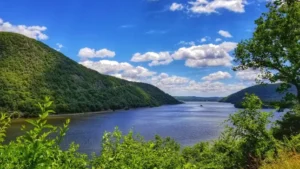
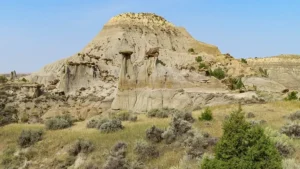


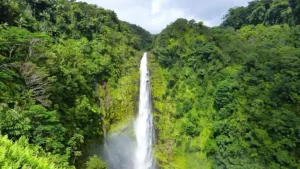

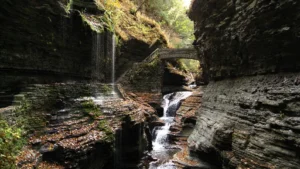


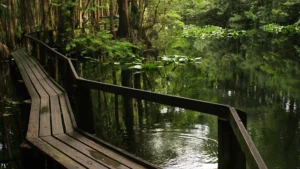
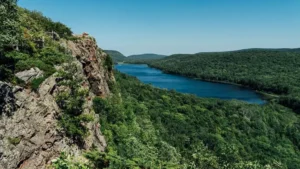
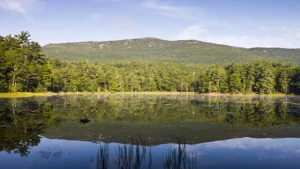
Leave your comment